Intel X58 Motherboard Roundup - What does $300 Get You?
by Gary Key on December 5, 2008 3:00 PM EST- Posted in
- Motherboards
Gigabyte GA-EX58-UD5
Features
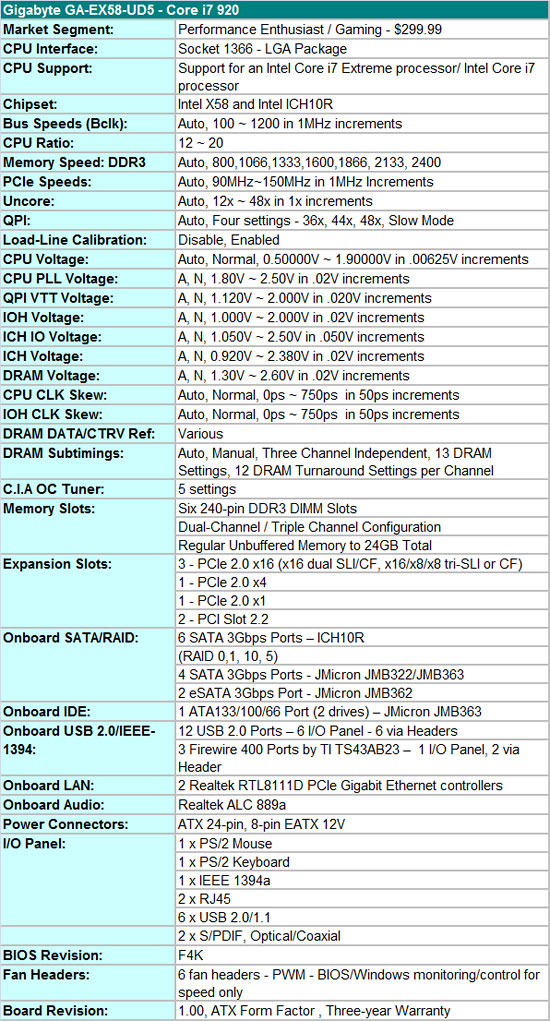
We have to hand it to Gigabyte; if there was an empty spot on the board during the design phase, they figured out a way to add a feature in that space. This board is loaded with everything but the kitchen sink and yet it appears mostly uncluttered; only when using the board do you sometimes notice that it is crowded. Gigabyte throws in twin Realtek RTL-8111D PCIe Gigabit Ethernet controllers that can be teamed; the Realtek ALC-889a is on board for HD audio and features real-time Dolby Digital Live encoding; JMicron’s JMB322/363 chipsets are tabbed for IDE and additional SATA port duties; TI is selected for IEEE 1394a; and the Intel ICH10R is onboard for primary storage purposes.
The BIOS is designed for those who like to tweak for a living. For some, the number of available options will be overwhelming while others will take joy in squeezing out every last little bit the board has to offer. The number of memory timing options is immense and includes the ability to setting timings for each individual channel. However, as we also found with the ASUS board, the auto settings are not always spot on.
Also, the latest beta BIOS we utilized (F4H) has a habit of overriding manual memory settings. This can be a good and bad decision on behalf of the BIOS. The good is that it will do its best to keep the user out of trouble; the bad is that when we manually tweak a board we would like to know when we are in trouble. In the end, the settings determined by the BIOS were always stable and performance was generally not detrimental. We will look at this as a glass half full situation. (update - BIOS F4K received today corrects this problem)
The only nitpick we truly have with the BIOS centers on Load-Line calibration. The purpose of this setting is to reduce VDroop and it works perfectly on the other boards. On our particular board sample we still noticed VDroop when a VCore setting of 1.425V resulted in 1.392V real. Gigabyte is aware of this and is working on it now. Otherwise, we commend Gigabyte for a well laid out BIOS and for offering the enthusiast just about every option one could use on a board.
Gigabyte supports a stock 800MHz ~ 2400MHz memory speed on the i920/i940 processors along with opening up QPI link speeds from a standard 4.800 GT/s up to 6.400 GT/s. They also include a slow mode QPI link speed for high Bclk testing. The board supports up to 24GB of DDR3 memory. We have not had any problems running 12GB of our Patriot or G.Skill DDR3-1600 kits with the latest F4H BIOS. Our final settings are at 1600 with 9-9-9-24 1T timings at 1.66V. Although the timings are looser than the other boards, performance is basically equal; only a user looking for that last bit of advantage in a benchmark would notice a difference.
The three PCI Express 2.0 x16 slots will operate in x16/x16 mode for 2x SLI/CF if the third x16 slot is empty. If you decide to place a PCIe RAID, network, audio, or TV tuner card in the third x16 slot, then the 2x SLI/CF configuration will operate in x16/x8 mode. 3x SLI/CF configurations will run in x16/x8/x8 mode. We had no problems running our ASUS Xonar D2X or Highpoint Rocket RAID cards in x16 slots two or three.
The Board
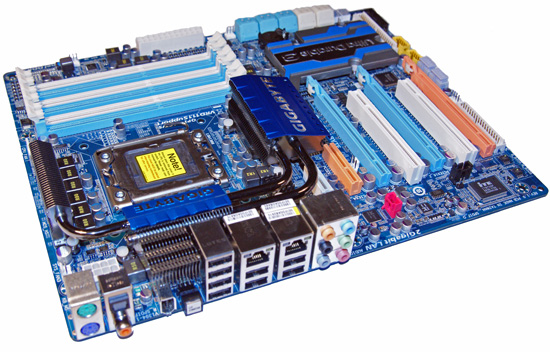
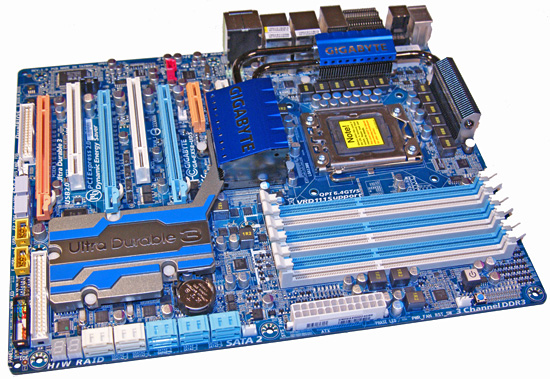
The $299 GA-EX58-UD5 is Gigabyte's mid-range X58 board, with the Extreme version being at the top end with a $330 price tag and the DS4 board placed at the low end with a $245 street price. We think Gigabyte's product separation is right on considering the feature set on each board, although we had hoped the DS4 would also have SLI capability considering the additional cost when compared to the MSI Platinum board.
Gigabyte introduced a new color palette on this board and we like it for the most part. We still notice a few of the crayola colors in use but overall this board would not look bad in a case with a large window. The one item that stands out on the board is the rather large heatsink for the ICH10R/JMicron controllers proudly displaying the Ultra Durable 3 technology incorporated on the board. Ultra Durable 3 refers to Gigabyte's use of solid-state Japanese capacitors, ferrite core chokes, and low RDS(on) MOSFETs along with an extra dose of copper in the board layers.
All of this is meant to improve overclocking potential and extend the life of the board. Until we get to our sub-zero overclocking article, it has been difficult to notice any overclocking differences between this board and the others in our roundup. However, we do appreciate the high quality components that Gigabyte included at this price point.
Gigabyte provides a hefty combination of heatsinks for the northbridge and vrm areas that link together with a heatpipe system. In fact, part of the first VRM heatsink extends into the IO panel to provide an exhaust outlet for the cooling system. Of course this system relies on radial type cooling for proper heat dispersion. We highly recommend direct air-cooling in this area if you are utilizing a tower heatsink/fan for the CPU or water-cooling when overclocking.
The CPU area is fairly open and our larger air coolers installed perfectly without interference from the heatsinks. However, a large air cooler like the Monsoon Vigor III that we utilized will render the first DIMM socket unusable, essentially limiting you to only populating three of the DIMM slots. This board features a two-phase power delivery system for the northbridge and a two-phase delivery for the memory subsystem. A twelve-phase power delivery design is utilized for the processor, which could be construed as overkill, but it does serve its purpose when overclocking. Like the other boards, the capacitors in the CPU area are fairly close to the 1366 socket, something that is important to note when utilizing other cooling methods like large water blocks, cascade, or LN2 setups.
The general layout is very good considering the vast number of ports, slots, and hardware included on the board. Gigabyte's design keeps interference to a minimum with installed peripherals for the most part. The board includes three PCI Express 2.0 x16 slots (x16/x8/x8), one PCIe x1 slot, a single x4 slot, and two PCI slots. This arrangement allows 3X Crossfire or SLI and still leaves the PCIe x1 and x4 slots open. However, using double slot cards for CF or SLI will render the PCI slots physically unusable. It is at this point that we realized a couple of potential problems with this layout.
The first PCIe x1 slot can only be utilized with a half length card, which excludes most audio and tuner cards. The bigger problem is that when utilizing two double slot cards for CF or SLI, the cards sit right next to each other, which inhibits airflow. The same holds true when utilizing the third x16 slot. When installing a dual-slot card in the third slot, it will hangover the board, which could create an installation problem in most cases. We do not care for 3X CF/SLI for general gaming, so we would have preferred a proper dual x16 design or an additional slot between the first two x16 slots to improve cooling or allow water-cooling on the GPUs.
At the rear of the board are the ten SATA ports, a Debug LED display unit, and the IDE connector. The gigantic heatsink covers the ICH10R and the JMB 363/322 controller chipsets. The JMB322s are responsible for the two white SATA ports and offer driver-free RAID 0 and 1 support. The hardware stack in the JMB322 makes arrays appear as standard hard drives and hence the lack of required software drivers when setting them up. Gigabyte took a different approach and hooked the JMB322s directly into JMB363 SATA ports instead of riding on the PCI Express bus as they do on the MSI board. This results in slightly lower performance as our PCMark Vantage HDD test suite will indicate later on. All ten SATA ports have a right angle cable connection scheme that allows them to be utilized even with the longer double-slot video cards. About the only drawback is placing this board in a smaller case where the drive bays would butt up against the board. Even so, we feel this arrangement is the right way to go.
In a change from other board designs, Gigabyte locates the power on and reset buttons behind the DIMM slots, an unusual location but one that we grew accustomed to quickly. At the front of the board Gigabyte places their dual BIOS chips, which can come in handy in case a flash attempt goes south. Also, they figured out a way to include a floppy connector, although we no longer care to see them on boards in this market sector. Gigabyte also throws in some onboard LEDs to light up your life. Actually, they do serve a purpose besides looking cool in a windowed case at night: the LEDs will let you know how many phases are being utilized by the board during operation.
The IO panel features eight USB 2.0 ports, two Ethernet jacks with LED indicators, an IEEE 1394a port, standard PS/2 keyboard/mouse ports, coaxial and optical S/PDIF output ports, and a handy clear CMOS button. The audio panel offers connections to the Realtek ALC 889a HD audio codec. The one thing missing on this board is a fixed eSATA port. However, Gigabyte includes an expansion slot backplate that allows an additional two external SATA ports via any of the board's internal SATA connections.
The Applications
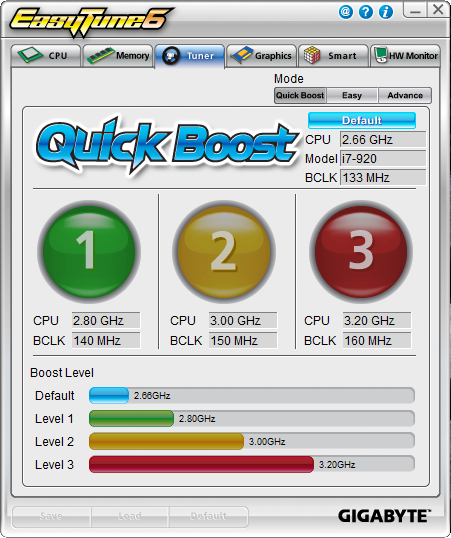
Gigabyte provides their EasyTune 6 application that provides monitoring, system information, and overclocking capabilities. This is one of the best applications provided by the various motherboard suppliers for tuning the system within Windows. We would still like to see the ability to save the settings to the BIOS or at least a BIOS profile; otherwise, this application is useful for extracting a fair amount of performance improvement out of the system within Windows.
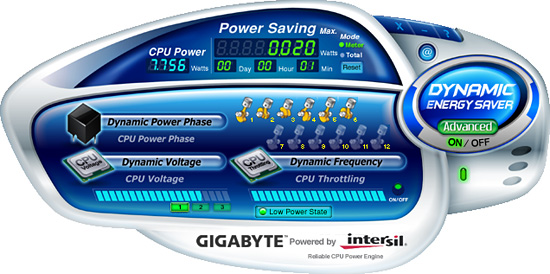
Gigabyte recently updated their DES (Dynamic Energy Saver) software so it is compatible with the X58 chipset, along with providing BIOS improvements. Our original F2 BIOS would not work properly with the latest DES beta but the F4 series has made great strides in this department. We noticed a 5W improvement in idle rates and a 1W improvement in our load tests with DES. Gigabyte expects some additional savings once the software and BIOS are finalized. The DES system offered fast switching times once a full load was placed on the system and we did not experience any crashes during our benchmark tests.






















78 Comments
View All Comments
belladog - Saturday, December 6, 2008 - link
Im glad Anandtech is taking a firmer stance with the motherboard makers. I too have seen a degradation in quality over the years.I take what review sites say with a grain of salt. People concerned about stabilty should go to the motherboards makers forums(or other user forums) to really see what to expect with a product.
You dont need to be einstein to realise that manufacturers send hand picked and tweaked products to review sites. Their sales figures depend on a good review, but then the masses who buy the boards/products from the shop see very different results.
Also its hard to poorly rate a product when reviewers have friendships at the companies or depend on advertising revenue from these same companies.
Whats the use of high overclocks if you cant get 4 Gigs of ram to work? Or your new PCI-E 2.0 Video card is having "compatibilty" problems with a board advertised to run it? Then they say its your PSU or memory. The PSU maker blames the motherboard, everyone blames each other and us suckers have to go out and buy 2 PSU's, 2 different ram kits and mix and match to get a working system.
I like to buy high end parts but my experience is its usually not worth it. Most "high end" boards, PSU's , memory are overpriced and provide little or no better experience than a mainstream parts at half the price, except maybe graphics cards where a high priced one will provide a better gaming experience on high settings.
Even in crossfire/SLI an X38/X48 board running at 16X/16X will perform no better than a mainstream P45 board running at 16X/8X. Even worse in some situations.
X58 is a little different because its a whole new architecture that looks interesting but really doesnt offer a huge performance gain. We will probably see the socket 1156 boards performing about the same if the past is anything to go by.
Anyway something needs to change in regards to reviews. Maybe review sites should only test parts obtained from retail channels. Maybe review sites should run a standardised lot of tests before even considering overclocking results. I expect all the advertised features to work correctly as advertised.
Like i said, the best thing consumers can do is, dont take too much notice of reviews and go to the manufacturers forum or other user forums to see what you're really in for.
stungun - Saturday, December 6, 2008 - link
I love the fact you are trying to implement changes in how you review hardware. Personally I do not overclock, dont want to but i do want the newer Intel processor/motherboard combo for 3d rendering and just because it is time to upgrade I should go with the future. Not all your readers want to burn up cpu components some of us just want a good honest working system.shocku - Saturday, December 6, 2008 - link
That's it?!After promising snippets for weeks, the final article is a compilation of what's been said before. That, and more promises future articles will be more in-depth about: RAM… non ES CPUs… the two or three X58 motherboards not covered here…, etc., etc., etc.
I appreciate all the work that goes on behind the scenes to make reviews. But at some point you gotta tell it like it is. If a BIOS or driver wasn't ready-- tough luck. There's plenty of room for other companies to shine by getting things right the first time. Or, are sites like Anandtech the new beta testers?
"We still have several boards to review, ranging from the $220 MSI Platinum up to the $400 Foxconn Bloodrage with several in-between. Our next review will focus on the "lower" end X58 boards from Intel, Gigabyte, Biostar, and MSI. Our final review will feature the upper end boards from ASUS, Gigabyte, DFI, and Foxconn. In between, we will provide a comprehensive OC guide along with a detailed look at memory performance with several DDR3 tri-channel kits from Corsair, OCZ, Patriot, GSkill, Kingston, Crucial, and Mushkin."
Say it isn’t so. Why did I read this article for?
I'll try going from the bottom up...
>I thought the Nehalem memory article was out already. There's that much memory performance left to be covered?
>How can readers make use of "a comprehensive OC guide" that's coming out before "upper end boards"? There's no point if a few bucks more can get you a board that goes as high as your attempts to OC the cheaper one. Might as well pay more and OC more, or pay less if both have the same ceiling.
>The next review will be about lower end boards like Intel's?! Huh?! The Smackover retails for over $250 USD. Unless they have a cheaper board nobody knows about, and they're ready to sell it now; there's NO SUCH THING as a low end X58 board this year.
This article's conclusion, as of 12/05/08, seems impartial and has constructive criticism for the board makers. Perhaps this whole series of articles and blogs will look good to someone reading them for the first time 6 months from now. But, right now, the article is just fodder.
Are readers better off with an expensive board they know thanks to this article, or should they get an even more expensive board that’s been skipped from this review? Heck, maybe the best is a cheaper one whose price puts it in the so-called ‘low end.’
These boards are not $1-$5 dollar items. So, say it like you mean it.
KTHX.
Or... charge manufacturers for all the beta testing you've done and the many 'second' chances they got before you went public. While you're at it, spare us from dealing with ads in your Web site.
PS: I wrote this before I read any comments. Boy am I not alone!
sidewinderx2 - Saturday, December 6, 2008 - link
Err... i'm pretty sure i'm just feeding a troll here... but here goes:Do you not understand what quotation marks mean? You know... somewhat sarcastic? they specifically put the word "lower" in quotation marks, so unless you truly have no grasp of the english language, you must be retarded to think that they actually meant those boards are "low end" boards.
"This article's conclusion, as of 12/05/08, seems impartial and has constructive criticism for the board makers. Perhaps this whole series of articles and blogs will look good to someone reading them for the first time 6 months from now. But, right now, the article is just fodder. "
So... what you're saying is... "WAAAAH! ANANDTECH DIDN'T TELL ME WHAT I SHOULD BUY! WAAAAH! THEY'RE TOO IMPARTIAL! WAAAH! THEY SHOULD BLINDLY GIVE ADVICE OVER THINGS THEY HAVEN'T TESTED YET! WAAAAAAAAH!"
Right.
LtPage1 - Friday, December 5, 2008 - link
Which companies have better quality control out of the gate is information of EXTREME relevance to the consumer. These boards are close enough together in pricing, features, and performance as makes no difference to me. Which company's board had the least problems when it was shipped to you would absolutely sway my purchase. Also, how quickly they dealt with problems you brought up, and how obsessed they were with overclocking performance results to the exclusion of basic functionality would be a huge factor for me.Inform the consumer! Report on hardware? Tell us which companies deserve our money.
chekk - Friday, December 5, 2008 - link
Perhaps you should send the mobo manufacturers a bill for your testing. It sounds like Anandtech provided a very valuable service since clearly the manufacturer's quality assurance processes are not up to the task.Yes, overclocking is fun, but if I buy a production board, it had better be production ready. Also, whether the board is $300 or $65, that sucker better work.
I'd actually like to know which manufacturers we're discussing as I'd like to stop supporting them with my dollars until they get a clue.
Ben - Friday, December 5, 2008 - link
It's hard not to rant here, but I know that rants often get passed over.You guys don't know what a relief it was to read this article. I've been building systems for many years and I have noticed the steady decline in quality.
My latest build was not only the most money I've ever spent on a computer, but also the worst experience I've ever had with a build. I've since sold it off as pieces, while I contemplate buying a preassembled workstation for the first time in my life.
The final straw for me was when I complained about a broken feature to a well-known manufacturer and they told me that I "should have known" what to expect from their product by reading their message boards. In other words, we know it says it does A, B, and C on the box, but if you read our message boards before you bought our product, then you would have known that it doesn't do A, B, and C.
I hope you guys can turn this situation around.
DBissett - Friday, December 5, 2008 - link
Anand's essay on this topic is some of the most important writing I've seen here. Unfortunately, the editorial slant of AT reviews, along with many other sites, has set the stage over the years for exactly what the complaint is about. Anand describes it well...the overriding interest, if not outright obsession, with what often amounts to miniscule performance advantages has literally buried the benefits of simple day to day dependability. Now that this situation has reached such extremes that Anand feels compelled to sound off about it, the task is to turn the editorial focus enough to raise dependability to the higher level of concern that it deserves. Some users in the forums point out at times that different settings or product differences make absolutely no difference in real world use. AT reviews should be equally candid and state, perhaps in bold type, when differences in observed speed are insignificant, and then NOT go on to rank order products on these insignificant speed differences. AT reviews should also go on to provide a rating or at least clear observations about the true ease of use, dependability and satisfaction to be expected by users in general or at different levels of experience, including BIOS issues that the manufacturer has not fixed. It sounds like this might be coming. Great! JDPowers ranks cars on something like initial problems/defects found by new buyers and there's no reason why similar polling/experiences shouldn't be provided for users of what are increasingly expensive computer parts. I hope Anand follows up on this issue and really institutes changes to address it.marsrunner - Friday, December 5, 2008 - link
Thanks for the roundup. Great reading.I bought the i7-920, 12GB of G.Skill PC3-1333 RAM and Asus P6T a couple of weeks ago, and have only had one real problem. My new Logitech Illuminated Keyboard causes the mobo to take about 3 minutes to initialize USB devices at POST, and then when it does POST the keyboard won't work at all until Vista takes over. Very irritating. Haven't contacted ASUS, because I'm sure they'd point the finger at Logitech, who would point the finger back at ASUS. Besides, the keyboard does not cause any problems on my other PC.
I should say that I don't and won't be doing any overclocking, unlike most people around here I imagine, but even so I've noticed a lack of attention to detail in these mobos.
Ecmaster76 - Friday, December 5, 2008 - link
Good article.However the feature tables are a rather large download. If you absolutely must post them as an image please use PNG or GIF. I resaved one in both formats and the size dropped in half without a loss in quality. JPEG is excellent where color content is more important than detail. However the indexed color of PNG and GIF is superior for a 2 color text table where the sharpness of the letters and not the exact shades of those two green is most important.
Also you have a next page link at the bottom of the last page that, of course, goes nowhere.